Serr tnin ya’rfouh alfin, goes the old Algerian saying, a secret known to two is soon known to thousands. But if that’s true, how is it that Algeria, a country of well over 35 million inhabitants, is still the best kept foodie destination in the Mediterranean?
It appears to be a marketing problem. Somewhere along the line “Moroccan cuisine” came to be the default umbrella term for North African cooking in the English-speaking world, much in the same way that “Lebanese food” is the tag applied to many Syrian and Palestinian restaurants and “Indian food” is often more commonly Pakistani or Bangladeshi.
Algerian restaurateurs outside of their home country routinely bill their establishments as Moroccan eateries as an easy shorthand, so that their customers know exactly what they’re getting. In fact, if you’ve ever eaten in a Moroccan restaurant outside of Morocco, you may well already have tried Algerian cuisine. But while this is an easy fix, and Algerian cooking does undoubtedly share many of the typical ingredients, influences, and characteristics of Moroccan food, to forget that Algerian cuisine has its own rich identity is to miss out on something special. It’s time to set the record straight.
Algeria is the largest country in Africa and the Mediterranean, and as such it encompasses a huge variety of landscapes and a complex cultural heritage, both of which have shaped the country’s food traditions. From its northern coast it takes a wealth of fresh seafood, while the desert south is home to date palm groves and hidden desert truffles. Successive waves of conquest by the Arabs, the Ottomans, and the French brought new ingredients and methodologies up against the traditional staples and techniques used by the itinerant Amazigh tribesmen, and out of this chaotic crucible Algerian cuisine emerged.
Algeria is the largest country in Africa and the Mediterranean, and as such it encompasses a huge variety of landscapes and a complex cultural heritage, both of which have shaped the country’s food traditions.
For now, the best – and frequently only – way to be sure you’re getting Algerian food is to take a trip there in person and try as many different things as you can. Here are a few things to look out for on your travels:
Breakfast
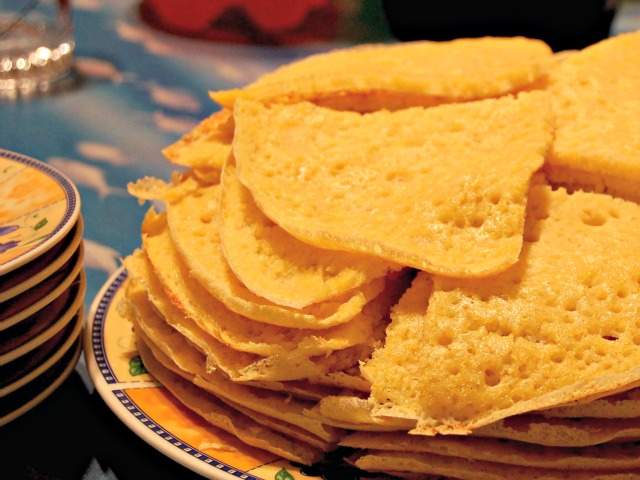
Fried, honey-soaked, sugar-dusted treats dominate an Algerian breakfast, making it the best meal of the day for those with a sweet tooth. A more simple breakfast may consist of fresh bread with jam and butter and some home baked date sweets. Both bread and sweets are entirely deserving of sections of their own, so for now, here are a few of Algeria’s other typical breakfast treats:
- Baghrir – The baghrir is a spongy semolina pancake that originated in the tribal Amazigh culture and is now popular throughout North Africa. The baghrir batter is made with yeast and rises in the pan to create hundreds of tiny holes; the more holes, the better. The hot pancake is then thoroughly doused with honey and sprinkled with almonds and softened raisins.
- Sfenj – If you prefer to take your breakfast deep fried, you’ll want to opt for a sfenj or two (or three), a kind of robust, puffy dough ring. Although they’re often described as donuts, sfenj have more of a crunch and a spring to them than American donuts and are actually closer in taste and texture to particularly fat Spanish churros. You can dust them in sugar or dip them in honey but either way the result is wickedly moreish.
- M’shewsha – Sitting somewhere in the grey area between omelets and French toast, rich and filling m’shewsha is another honey-infused way to start the day. It’s considered so nourishing in fact, that it’s often prepared for women who’ve just given birth or for manual laborers heading out for a heavy day’s work. However, it works just as well as fuel for independent travelers with a day of exploring ahead of them, and it tastes pretty unbeatable too.
- Coffee – Algerian coffee comes strong and thick. It is often flavored with ground cardamom, or more rarely with orange blossom water called mazhar, which crops up time and again in all areas of Algerian cooking. Even now, wherever I am in the world, the smell of mazhar always takes me right back to Algeria.
[social]
The essentials

- Couscous – Of course you already know what couscous is. Or so you might think. But let’s get a few things straight. If you can buy it in a plastic pot from a supermarket or cafe, mixed with a few sad chunks of olive and pepper and the odd raisin, then it’s not couscous. If you can tip the dried, flavored grains from a packet, cover it with hot water from the kettle, leave for five minutes and then “fluff with a fork”, then it’s not couscous. And if it arrives in an airplane meal tray and is so dense it can actually be sliced, then, Air France, it’s definitely not couscous. Real couscous is steamed slowly and repeatedly over a pot of hot stew and rubbed between oiled palms in between each steaming session to separate each and every fluffy grain. The result is feather-light and delicately seasoned, the ideal accompaniment to soak up the juices of a rich vegetable, chicken or meat stew. Look out for different kinds of couscous grain, from fat berkoukes pasta to tasty barley couscous.
- Mechoui – This dish consists of an entire lamb, ever so slowly spit roasted over an open fire. Algerian lamb tends to be more muttony than many people are used to, in other words, you really know you’re eating lamb and not any other kind of red meat. When cooked well, the skin is crispy and crackling while the meat falls away from the bone and melts in your mouth with a buttery fullness. Be prepared to serve yourself buffet-style by pulling morsels from the bone by hand.
- Merguez – These spicy lamb sausages are one of few Algerian foods that can be bought outside of the country in both restaurants or in the shops and that closely resemble the real deal. Some merguez have ground beef mixed into the lamb, but something they all have in common is a good helping of cumin and spicy harissa.
- Tagine – In Morocco, a tagine is a thick stew of meat, chicken, or fish and vegetables slow-cooked to succulence in an earthen conical pot. In Tunisia, on the other hand, a tagine more closely resembles an egg-based vegetable and meat frittata. Trapped between the two, Algeria takes the middle ground and uses the same name for both kinds of the dish and many other interpretations in between. As a result, it can be tricky to know what you’re getting when you order a tagine in Algeria, but it’s probably safest to assume that you’ll be getting the stew kind (unless you’re in Eastern Algeria).
- Pasta – Before you try your first Algerian pasta dish, try to forget everything you know about its better-known Italian cousin from across the Mediterranean. Rather than being boiled in salt water, Algerian pasta is generally steamed atop a broth in the same way as couscous, so that it soaks up the flavors of the sauce during the cooking process. You’ll find that the dishes vary a lot from region to region, but they tend to be served with a chicken or meat broth along with chickpeas and boiled egg. There are also many variations of the pasta itself, such as trida (a wafer-like square confetti), dwida (similar to angel hair vermicelli) and tlitli (like orzo or large grains of rice), to name just a few you might come across.
We have over 70 articles about food around the world. Check them all out on our Food Page.
Street Food
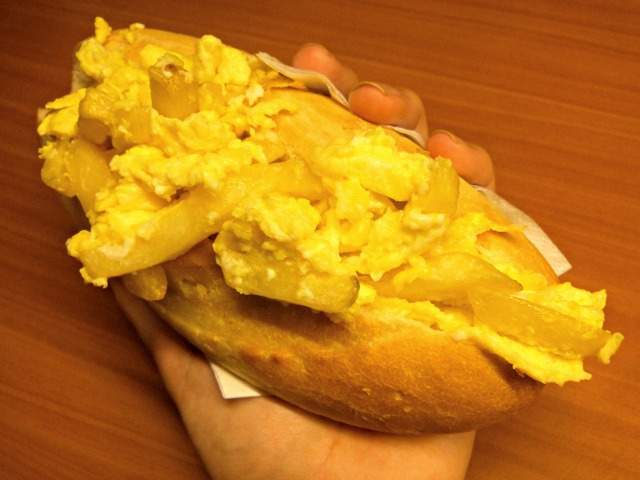
There is a real street food culture in Algeria, so it’s perhaps a little surprising that there’s not more to say about it. That’s because most of the street food you’ll find in Algeria is largely the same as street food you could find anywhere else in the world. Cheap and easy pizzas, crusty sandwiches, ice cream, etc. – there’s nothing there that requires too much explanation. However, there are a few quintessentially Algerian foods-to-go that you should try if you get the chance.
- Frites-Omelette – The no-nonsense frites-omelette translates as ‘French fry omelet’ and that’s exactly what it is, although the egg is closer to scrambled eggs than an actual omelet. This filling snack is either served as it is or comes wedged inside a crunchy French baguette. If it comes greasy and salty, congratulations, it’s just right!
- Garantita – If you get bored of French fry omelet sandwich, you can always mix things up with a chickpea omelet sandwich instead! A hugely popular fast food, the garantita is made from ground chickpeas and cooked until crunchy round the edges but still doughy in the middle. Slap on some spicy harissa sauce and sandwich between crusty white bread, and you’re set to carry on exploring.
- Savory pancakes – Maghlouga pancakes are popular in the Mzab Valley that lies on the edge of the Sahara Desert. In fact, each of the region’s five ancient cities has its own variation on the dish, but essentially a maghlouga is a semolina pancake stuffed with ground meat, vegetables, and onions. Mhajeb pancakes, on the other hand, are stuffed with a mix of tomato, onion, and pepper and are easily found throughout Algeria.
Only for the adventurous
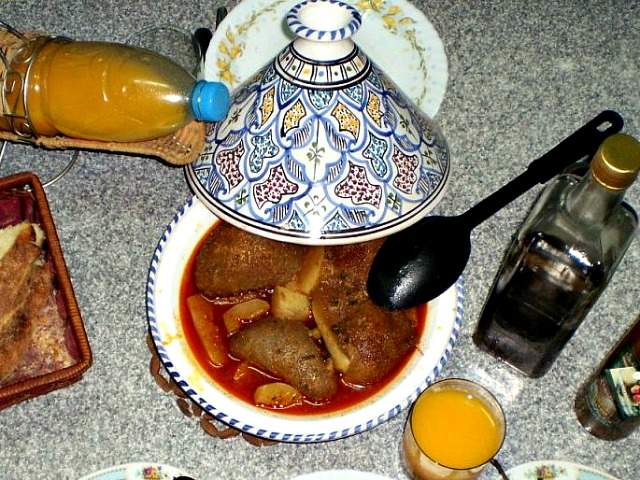
Of course if you’re a true foodie, you’ll know that exploring a new country’s cuisine is about more than sticking to the tried and tested safe options. Some of life’s most intriguing culinary discoveries happen when we step outside of our dietary comfort zones, and there’s plenty of scope for that in Algeria.
- Bouzellouf – Bouzellouf is a dainty sounding name for a not entirely dainty dish consisting of a sheep’s head and feet. The head is roasted on an open fire and then usually split down the middle, exposing half a brain, half a tongue and one whole eye for your enjoyment. I once read somewhere that the idea that some Algerians eat everything including the sheep’s eye in a bouzellouf is pure mythology. Well take it from someone who’s seen it first hand – it isn’t, so tuck in!
- Kourdass – These little bundles of flavor consist of sections of lamb tripe stuffed with chunks of spiced meat, lace fat, lung, and intestines, which are hung outside in the sun until good and dry. I was once staying in a house where the cook, after deciding to make an early start on stewing the kourdass for lunch, roused the anger of the other residents who had been awoken by the smell alone and had run shouting to the kitchen, perhaps suspecting they were under some kind of chemical attack. It certainly has a potent and definitively sheepy aroma. But I am assured that if you can get it close enough to your mouth to eat it, it makes for a delicious if salty delicacy.
- Osbane – Algeria’s answer to the Scottish haggis, osbane is another dish that makes use of parts of the sheep that often go to waste in other regions of the world. The osbane is a sheep stomach packed tight with spiced lung, liver, intestines and a handful of chickpeas and then boiled into submission over several hours in a tomato-based sauce. When cooked it slices like butter and is best enjoyed with a hunk of fresh bread to soak up the flavorsome sauce.
Bread
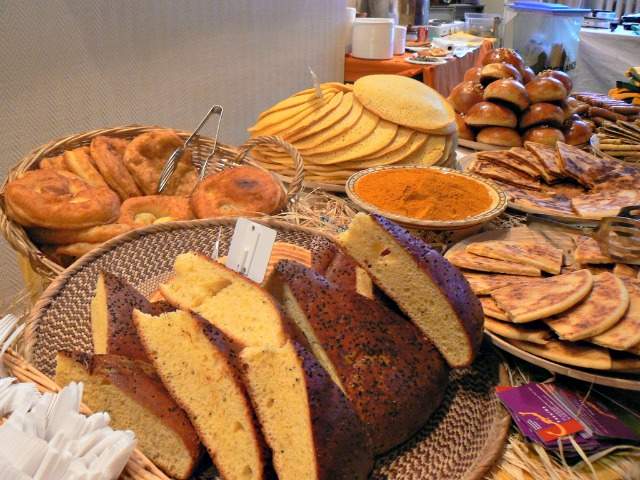
Bread is a key element of Algerian cuisine, replacing not only rice, pasta, and potatoes but also knives and forks in many cases. You may find that bread is served with pretty much everything from breakfast to salad dishes to stews (with the possible exception of couscous) but then again, there are enough varieties of Algerian bread to keep you from repeating yourself for a good while.
- Khobz dar – Literally “homemade bread”, khobz dar is a bit of a peculiar name since most of Algeria’s breads are still traditionally baked in the home and the name actually refers to a specific kind of fluffy semolina bread. The soft crust and sweet edge give this bread the air of a brioche, whilst its spongy texture make it the bread of choice for dipping into stews and soups.
- Kesra – There are two kinds of kesra, a thick and a thin kind, but both are round and flat and made from a dense semolina dough. Although their solid nature means they’re not so great for sopping up the juices from your tagine, it does make them perfect for shoveling up large scoops of dip.
- Khobz sha’ir – If you’re feeling the weight of all those carbs, try to get your hands on some of Algeria’s traditional barley bread for a change. It’s another heavy flatbread, cooked on a clay pan rather than baked in the oven, and while you can enjoy it along with a saucy main dish, it has enough of its own personality to be simply dipped in olive oil or honey.
Desserts
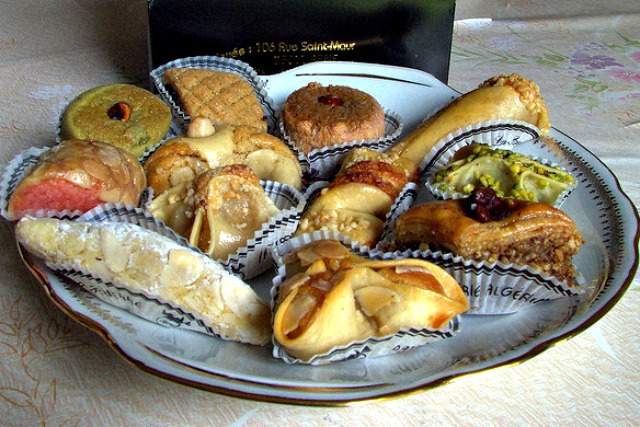
You’ve probably already worked it out just by looking at the breakfast selection, but just in case I failed to hammer it home, Algeria is a nation made by sweet lovers, for sweet lovers.
- Qalb ellouz – This dessert is a favorite during the month of Ramadan, when daytime fasting creates the perfect excuse for indulging in sticky, artery-clogging cakes as soon as the sun goes down. A sandwich of syrupy semolina is split with a filling of ground almonds and cinnamon, all infused with the heavy scent of orange blossom water.
- Rfiss – Rfiss is another of those tricky Algerian dishes that causes more confusion than it solves, since it is actually a collection of several entirely distinct desserts that share what appears to be the same name. Rfiss tounsi will get you a small crunchy date and semolina cookie, while rfiss in the north-central areas of the country might be an entirely unrelated dish of shredded pancakes soaked in syrup. A personal favorite is constantine rfiss, made from crushed, steamed semolina biscuits and copious quantities of ground almonds and orange blossom water and is far too easy to eat. But in the end it doesn’t really matter which one arrives, since they’re all tasty in their own way.
- Tamina – If semolina pudding fell out of favor outside Algeria a good 50 years ago, doomed to be forever remembered as a cloying school dinner staple, that’s because frankly we were doing it wrong, as one mouthful of tamina will tell you. Algeria combines some of its often repeated ingredients (toasted semolina, butter, honey and more honey) and serves up the ultimate comfort food. Eat it while still warm for an oozing pool of honeyed goodness, or wait until it cools for sturdier dessert.
- Fruit – Fortunately, for those who aren’t keen to eat themselves into a sugar coma from which they may never recover, there are a few dessert options that make the most of Algeria’s wonderful fresh fruit. Slices of fresh orange soaked in juice tinged with orange blossom water, early fresh figs, and countless varieties of dates each with their own unique character are all on the menu.
- Cakes – Once, as I was flying out of Algiers with a large box of assorted patisserie on my lap, the plane I was on began to vibrate alarmingly, and the captain announced in urgent tones that we’d be heading immediately back to the airport for an emergency landing. Yet as I pictured what I felt certain was my imminent demise, my first and only thought was “Oh! What a shame the cakes won’t get eaten!” That is how good Algerian cakes are. Almonds, pistachios, walnuts, and dates flavored with orange blossom and rose water and wrapped, twisted and layered in every combination you can imagine. Take some time to find the one that suits you, because there will be at least one.
Drink
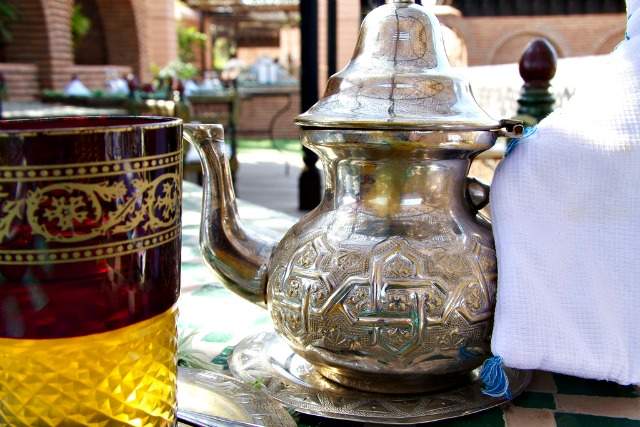
Since Algeria is a Muslim country, it isn’t somewhere you’d travel to find a wide range of home-grown cocktails or spirits. It does, however, have a long established tradition of wine production and you may find this on sale in some areas, especially the capital and in tourist hubs, along with some of these other typically Algerian drinks:
- Mint tea – If you’ve ever drunk Moroccan mint tea, then you’ve drunk Algerian mint tea as it’s all one and the same. It’s worth knowing though that cafes catering to tourists often use less mint and compensate by adding more sugar, resulting in a bland and sickly syrup. True mint tea can be smelled across the room before you even see it and retains a slightly bitter edge.
- Selecto – Algerian Selecto soda looks for all the world like a cola drink, which makes drinking it for the first time a bit of a shock to the senses. In fact, in spite of being cola brown, Selecto is apparently apple flavored, although it doesn’t taste much like apple either. Whatever the flavor, drinking Selecto is just as authentically Algerian as drinking mint tea, even if it feels slightly less exotic.
- Lben and Rayeb – Outside of Algeria, “curdled” and “fermented” are two concepts that many people prefer to keep away from their milk, yet Algerian rayeb is a celebration of exactly that. There’s no denying that it’s an acquired taste – something like sour Greek yoghurt with a fizzy edge, if you’re wondering – but don’t write it off before you’ve tried it. After all, some people like it! But if you don’t have the time to learn to love rayeb you might prefer to start off with lben which is a similar drink but is only curdled, not fermented, so it can be easier to get along with.
Budgeting
As with traveling anywhere in the world, your food budget will depend greatly on what you want to eat and where you want to eat it. You can pick up snacks and street food from popular joints for just a few US dollars on the streets of the capital Algiers, while a decent meal in a mid-range restaurant will cost you closer to $6-7USD a head without drinks. While options outside the capital may sometimes be more limited, in Algiers you’ll also find plenty of restaurants catering to those with a more substantial budget.
It may feel as though I’ve been going on forever about Algerian food, but this is really only a tiny taste of Algerian cuisine. The best advice I could give anyone about Algerian cuisine is to put their preconceptions aside, head to Algeria,and tuck in. It’s well worth the leap of faith.
For more on travel to Algeria, check out the following articles and resources:
- Should you add Algeria to a RTW trip?
- Find out why Algeria is one of the next big backpacking destinations
- Algeria isn’t tops on travel wish lists, but find out why you should go there now
Photo credits: 1 – abdou.w, 2 – PnP!, 4 – amekinfo, 5 – zaama09, 6 – Canon S3 IS in Paris, France, 7 – thegirlrg, all others courtesy of the author and may not be used without permission.
